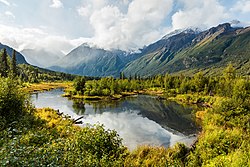
Landscape genetics is the scientific discipline that combines population genetics and landscape ecology. It broadly encompasses any study that analyses plant or animal population genetic data in conjunction with data on the landscape features and matrix quality where the sampled population lives. This allows for the analysis of microevolutionary processes affecting the species in light of landscape spatial patterns, providing a more realistic view of how populations interact with their environments . [1] Landscape genetics attempts to determine which landscape features are barriers to dispersal and gene flow, how human-induced landscape changes affect the evolution of populations, the source-sink dynamics of a given population, and how diseases or invasive species spread across landscapes. [2]
Contents
- History
- Advances and applications
- Methods
- Genetic markers
- Landscape and environmental features
- Statistical tools
- Example
- Sub-disciplines
- Seascape genetics
- Landscape genomics
- Pitfalls
- References
Landscape genetics differs from the fields of biogeography and phylogeography by providing information at finer temporal and spatial scales (i.e., at the level of individual genetic variation within a population). Because it focuses on sampling individuals, landscape genetics has the advantage of not having to subjectively define discrete populations prior to analysis. Genetic tools are used to detect abrupt genetic differences between individuals within a population and statistical tools are used to correlate these genetic discontinuities with landscape and environmental features. [3] The results of landscape genetics studies have potentially important applications to conservation biology and land management practices. [3]

